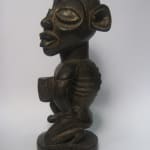Kongo Wooden Sculpture of a Kneeling Man, 20th Century CE
Wood
12
PF.5614 (LSO)
Further images
This remarkable sculpture represents a kneeling male with wide, almond eyes and an open mouth which indicates its origin with the Kongo group of what was once Zaire. It is...
This remarkable sculpture represents a kneeling male with wide, almond eyes and an open mouth which indicates its origin with the Kongo group of what was once Zaire. It is in an aggressive pose with hands on hips and one knee up, the penis prominently displayed. The Kongo have a “language” of postures in their artworks (Bimpangula), which reflect sentiments and attitudes to the viewers. The best-known is the telama lwimbanganga, a threatening pose involving the brandishing of a weapon. The current pose is one which African children on both sides of the Atlantic are generally banned from adopting, as it implies confrontation that is laudable in sculpture and reprehensible in polite society. The fearsome aspects of this figure are enhanced by the glaring eyes, open mouth with teeth, and the unusual, fan-shaped ears. The exposed penis is also very provocative as this is a shocking sight to most African societies. The drum-shaped protuberance on the chest was may represent a magical charge (bilongo). The indication of the ribs and spinal cord is also very unusual and may refer to the common Kongo disease called lubanzi (literally meaning “ribs”, a chest ailment including pneumonia).
The Kongo (or Bakongo) people live in what was once Zaire (the DRC, Angola and the Congo). The polity includes various smaller entities, which were modified by the 16th century kingdom of Loango, and the arrival of the first Portuguese explorers. The kingdom absorbed European traditions and religion with much of their indigenous culture intact. Indigenous Kongo society was based around the kingship model, not unlike that of the Nigerian Kingdom of Benin. Their religious beliefs are centred on a reverence for the dead, who are believed to be able to assist in the determination of future destinies. They are also believed to inhabit minkisi (singular nkisi), or charms, that can be appealed to for assistance in times of duress or uncertainty.
The most notable pieces of Kongo sculpture are the Nkisi Nkondi figures – often referred to as nail fetishes – which carry a packet of magical materials known as a bilongo; the figures are insulted and “hurt” with explosions and nails so that they will carry out the wishes of their tormentor. Various other categories also exist, such as the ntadi limestone grave markers and maternity figures with characteristic open-mouths, almond-shaped eyes and detailed surface work. Their poses are highly significant (see above), and are designed to strike fear into the hearts of miscreants.
This is a superb and unusual piece of Kongo sculpture.
The Kongo (or Bakongo) people live in what was once Zaire (the DRC, Angola and the Congo). The polity includes various smaller entities, which were modified by the 16th century kingdom of Loango, and the arrival of the first Portuguese explorers. The kingdom absorbed European traditions and religion with much of their indigenous culture intact. Indigenous Kongo society was based around the kingship model, not unlike that of the Nigerian Kingdom of Benin. Their religious beliefs are centred on a reverence for the dead, who are believed to be able to assist in the determination of future destinies. They are also believed to inhabit minkisi (singular nkisi), or charms, that can be appealed to for assistance in times of duress or uncertainty.
The most notable pieces of Kongo sculpture are the Nkisi Nkondi figures – often referred to as nail fetishes – which carry a packet of magical materials known as a bilongo; the figures are insulted and “hurt” with explosions and nails so that they will carry out the wishes of their tormentor. Various other categories also exist, such as the ntadi limestone grave markers and maternity figures with characteristic open-mouths, almond-shaped eyes and detailed surface work. Their poses are highly significant (see above), and are designed to strike fear into the hearts of miscreants.
This is a superb and unusual piece of Kongo sculpture.







